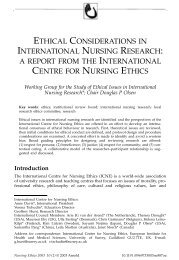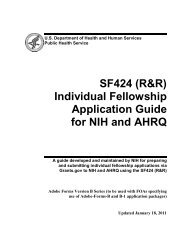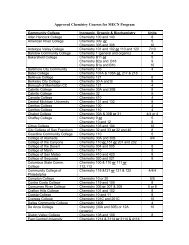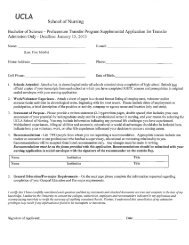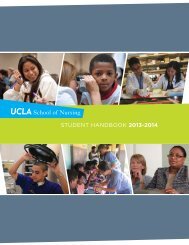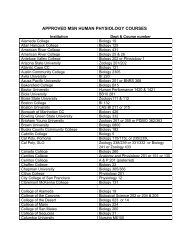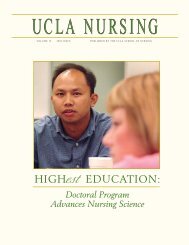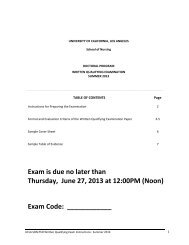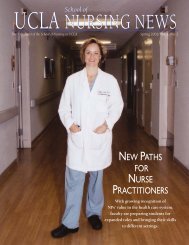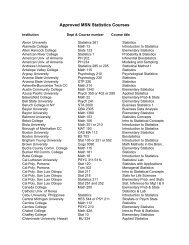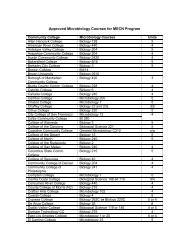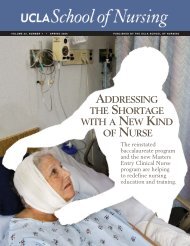proof positive - UCLA School of Nursing
proof positive - UCLA School of Nursing
proof positive - UCLA School of Nursing
You also want an ePaper? Increase the reach of your titles
YUMPU automatically turns print PDFs into web optimized ePapers that Google loves.
transforming nursing science<br />
AURELIA MACABASCO-O’CONNELL<br />
In her efforts to determine the most<br />
effective ways <strong>of</strong> educating low-income<br />
underserved minority populations on<br />
reducing their cardiovascular risk factors<br />
and improving their health, Dr. Aurelia<br />
Macabasco-O’Connell recently added a<br />
biological component to research that was<br />
once purely behavioral.<br />
Macabasco-O’Connell, an assistant<br />
pr<strong>of</strong>essor at the <strong>UCLA</strong> <strong>School</strong> <strong>of</strong> <strong>Nursing</strong>,<br />
has become interested in using biomarkers<br />
– early biological indicators <strong>of</strong> disease<br />
risk – to screen patients for left ventricular<br />
dysfunction. The goal is to identify these<br />
patients at a time when interventions to<br />
prevent further progression toward heart<br />
failure are most likely to succeed.<br />
Macabasco-O’Connell’s research team<br />
has focused on B-type natriuretic peptide<br />
(BNP), a hormone secreted from the heart<br />
as it starts to stretch. Detectable in a simple<br />
blood test, BNP has been shown to be<br />
elevated in patients with heart failure.<br />
Macabasco-O’Connell’s group is seeking<br />
to determine whether BNP can be used as<br />
an early screening tool for patients who<br />
have left ventricular dysfunction but<br />
remain without symptoms. A pilot study<br />
with a low-income, uninsured Hispanic<br />
population found that BNP was useful<br />
in detecting asymptomatic patients as<br />
confirmed by the gold standard for<br />
diagnosis, echocardiography.<br />
“Many <strong>of</strong> these patients were walking<br />
around thinking there was nothing wrong<br />
with their heart despite knowing they<br />
had high blood pressure and diabetes,<br />
which are risk factors for developing heart<br />
failure,” Macabasco-O’Connell says. “The<br />
BNP measurement provided us with an<br />
opportunity to educate these patients<br />
about the importance <strong>of</strong> treating these<br />
risk factors by explaining to them that<br />
there was already some dysfunction even<br />
though they didn’t yet feel it.”<br />
Macabasco-O’Connell hopes to be<br />
able to confirm the utility <strong>of</strong> BNP blood<br />
tests in a larger study. She is currently<br />
targeting a younger population, going into<br />
the community to conduct screenings<br />
that are designed to determine whether<br />
left ventricular dysfunction can be found<br />
even earlier – and whether such screenings<br />
can improve community awareness and<br />
enhance efforts to promote preventive<br />
strategies.<br />
“Too <strong>of</strong>ten, particularly among lowincome,<br />
uninsured and underinsured<br />
patients, we detect problems only when<br />
patients end up in the emergency room<br />
and have full-blown heart failure,”<br />
Macabasco-O’Connell says. “By that point,<br />
treatment is more challenging and these<br />
patients typically need to be hospitalized<br />
and re-hospitalized, which is both a<br />
burden to them and a high cost to the<br />
health care system. Biomarkers, combined<br />
with education, <strong>of</strong>fer an opportunity to<br />
detect these patients earlier, get them into<br />
the system, and prevent more <strong>of</strong> them<br />
from reaching that point.”<br />
10 <strong>UCLA</strong> SCHOOL OF NURSING fall 2010



